|
Click Here to return to Boston Illustrated Content Page Click Here to return to Previous Chapter |
 (HOME) |
|
Click Here to return to Boston Illustrated Content Page Click Here to return to Previous Chapter |
 (HOME) |
|
VII. NEW BOSTON AND THE SUBURBS, Final
Section.
Memorial Hall is architecturally the finest building connected with the university, and was erected by the alumni to commemorate the sons of Harvard who died in the civil war. It was built between 1870 and 1877, at a cost of $500,000, and is of brick and sandstone, 310 feet long and 115 feet wide. The central division is the Memorial Transept, 115 feet long and 58 feet high to the handsome wooden vaulting, and having high black-walnut screens around the walls, in which are set twenty-eight marble tablets bearing the names of the fallen patriots, and the places and times of their deaths. Over this transept the great tower rises to the height of 200 feet, and forms a conspicuous landmark. The great hall opens from the transept, and is 164 feet long, 60 feet wide, and 80 feet high to its splendid timber roof, with galleries at either end, and at the west end an immense stained-glass window, bearing the arms of the Republic, the State, and the University. The high wainscoting around the hall is adorned with scores of portraits and busts of ancient and modern worthies of New England and of Harvard, rare productions from the pencils of Copley, Stuart, Trumbull, Hunt, Harding, Powers, Story, Crawford, Greenough, and other eminent artists (descriptive catalogues at the east end). The hall is now used as the refectory of the students. The Sanders Theatre is entered from the other side of the transept, and is a beautiful semicircular hall with graded seats, accommodating 1,500 persons. 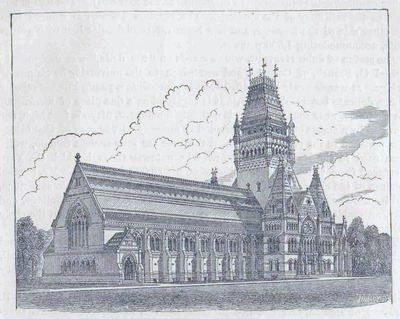 Memorial Hall. 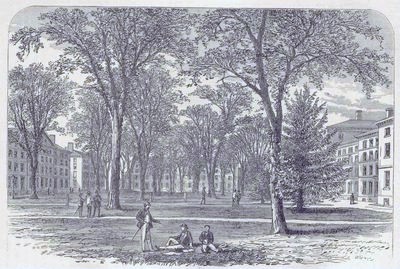 View of Harvard College: The Quadrangle. The statue of John Harvard, which stands on “the delta,” was designed by Daniel G. French, of Concord, and was given to the university by Samuel J. Bridge. It was dedicated Oct. 15, 1884. It represents a young Puritan scholar, with a delicate but resolute face. It is regarded as a fine piece of work. On the Common, near the university, is a stately monument, fifty-six feet high, and crowned by a statue of a soldier, erected in memory of 938 men of Cambridge who perished in the civil war. About the base are four ancient cannon, which were used in the Revolutionary war. The gateway through which the Yard is entered from the west is the outcome of a $10,000 fund left by Mr. Samuel Johnson of the class of 1855. It is built of granite, assorted brick, sandstone, and iron. The panels are carved with the shields of the State, College, and City, an emblem to the donor, and the nation, and quotations from the early College history, and Colonial Records. The Protestant Episcopal Theological School is near the University, but not of it, and consists of a noble group of stone buildings, including Lawrence Hall, the dormitory; Reed Hall, a cloistered Gothic building containing the library and lecture-rooms; and the exquisite architectural gem of St. John’s Memorial Chapel. This school was founded in 1867, on an endowment from Mr. B. T. Reed of Boston, and has five professors. The number of students averages about thirty-five. It is on Brattle Street, near the Longfellow House, and opposite the stately old Vassal House, which was erected about the year 1700, and was afterwards abandoned by the Royalist family of Vassal. The Riverside Press is three-fourths of a mile south of Harvard College, and is reached from Boston by the Brighton, Western Avenue, Pearl Street, Putnam Avenue, or River Street horse-cars, from Bowdoin Square. It was established here in 1851, by H. 0. Houghton & Co., in an abandoned city building; and the establishment, as now conducted by the same firm, covers nearly four acres, between Blackstone Street and the Charles River, the main edifice being a handsome brick building, four stories high, with a front of one hundred and fifty feet and a depth of one hundred and sixty feet. In the rear are the fire-proof warehouses for paper and plates, the electrotype-foundry, and a stone pier along the river front. The appointments of the Press are very complete in all departments. These include a bindery famous for the variety of its work, and a large lithographic department. Between five and six hundred persons are employed here, having their own library, savings department, and fire-company. The publications of Houghton, Mifflin & Co., 4 Park Street, Boston, are all manufactured here, and there is direct telephonic communication by private wire between the Press and the Boston office. 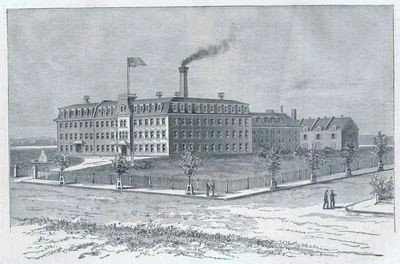 The Riverside Press. Cambridge is noted not only for being the seat of the first college in America, but for having been the first place in the country where a printing-press was set up. In 1639 a press was brought over from England, and put in operation in the house of the president, who had the sole charge of it for many years. The first thing printed upon it was the Freeman’s Oath, followed by an Almanack for New England, and the Psalms. A fragment of the last-named work is preserved in the college library, and copies of it may still be seen in some antiquarian libraries. Cambridge has at the present day some of the largest and most completely furnished printing-offices in America, conspicuous among which are the Riverside Press just described, and the University Press, offices which are perhaps the most celebrated in the country for the quality and accuracy of their work. Many of the hundreds of thousands of books published annually in Boston, and not a few of those issued by publishers in New York, including illustrated books requiring the finest workmanship and the greatest care, are printed and bound at these establishments. Not very far from the college grounds stands one of the few famous trees of th e country, — the Washington Elm, — the only survivor of the ancient forest that originally covered all this part of Cambridge. It was under this tree that General Washington took command of the Continental army on the morning of the 3d of July, 1775. A neat fence surrounds the famous tree, and an inscription commemorates the important event which was the most interesting in its centuries of existence. 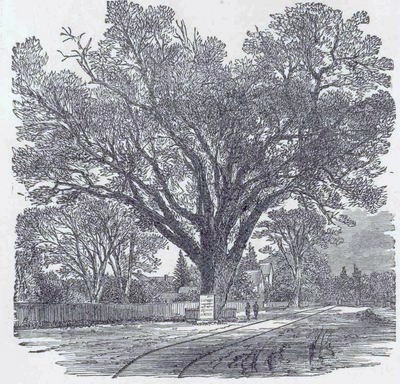 The Washington Elm, Cambridge. At a short distance from this old elm, on the road to Watertown, near Brattle Street, stands the house used by the patriot general as his headquarters It was previously the residence of Colonel John Vassal, a Royalist or Tory, but was used by General Washington on its abandonment by the owner; and here continued to be the headquarters of the American army for the greater part of the time, until the evacuation of Boston by the British in the spring of 1776. The house stands in a large and beautiful lot of ground, a little distance from the street, in the midst of tall trees and shrubbery, and though in a style of architecture different from that now generally employed, it is still an elegant residence in external appearance, while the rich and costly finish of the interior has been preserved by its successive owners. The poet Henry Wadsworth Longfellow w a s long the possessor a n d occupant of this house, and here he died in the spring of 1882. 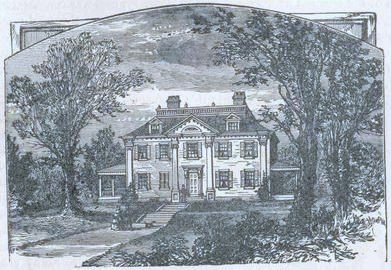 Residence of the late H. W. Longfellow. Mount Auburn Cemetery is situated partly in Cambridge and partly in Watertown. The land was originally purchased and improved by the Massachusetts Horticultural Society for an experimental garden. It subsequently passed into the hands of the trustees of Mount Auburn Cemetery, and was consecrated in the year 1831. It is now one of the most extensive cities of the dead used by the people of Boston, being in extent about one hundred and twenty-five acres. The surface is remarkably diversified, giving unusual opportunities to the landscape-gardener to improve the natural beauty of the scenery. There are several sheets of water, and high hills and deep vales in abundance. Trees in great variety have been transplanted into this enclosure, adding greatly to its beauty. Upon the summit of the highest hill, Mount Auburn proper, a stone tower has been erected, from which a very fine view of all the surrounding country can be obtained. Many elegant and costly monuments adorn the ground in every part. Some of these have been erected and the expense defrayed by public subscription, but many more by surviving friends of the thousands who here sleep the last sleep. The granite entrance-gate was designed from an Egyptian model, and was erected at a cost of about $10,000. The very beautiful chapel was built in 1848, at an expense of $25,000. It is used for funeral services at the cemetery. There are around the walls, within, several excellent statues and memorials, one of which, a statue of James Otis, by Crawford, is particularly to be admired. Cambridge has been connected recently with the newer part of Boston by the Harvard Bridge, which extends from the foot of Front Street on the Cambridge side to the junction of Beacon Street and West Chester Park in Boston. The first contract was made in August, 1887, and at present (February, 1890) the bridge is practically finished, and will be opened as soon as the approaches on the Cambridge side can be completed. 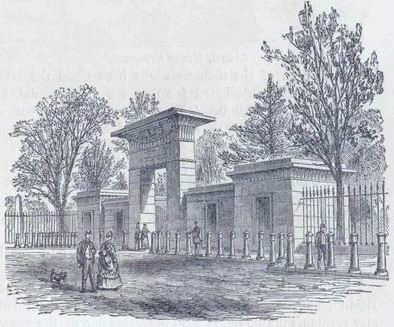 Entrance to Mount Auburn. 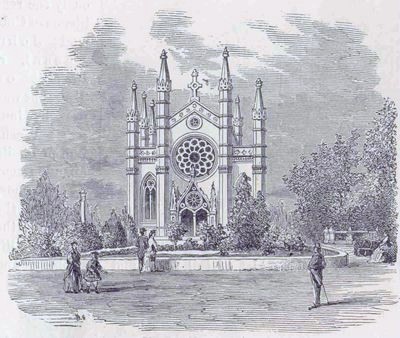 Chapel, Mount Auburn. Brookline is one of the most beautiful of the suburban towns surrounding Boston, and furnishes a large proportion of the delightful drives in which the city residents indulge. It also possesses one of the finest specimens of church architecture in the State. The Harvard Church, of which we give a representation, is a beautiful edifice both without and within. 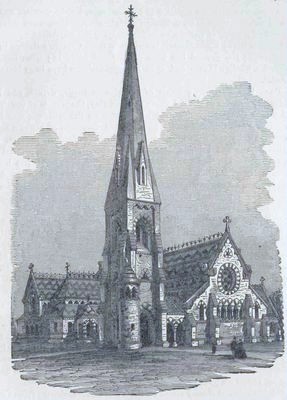 Harvard Congregational Church, Brookline. It is by no means to be understood that in our glance at the suburbs we have exhausted the subject. There are a great many other points that should be visited. The magnificent beach at Revere is of itself a sight well worth the time spent in driving thither. A short visit should be made to Lynn, the headquarters of the shoe manufacture, and another to the extensive factories of Lowell and Lawrence. In the church at Quincy are the tombs of the two Presidents, John and John Quincy Adams. Newton, Belmont, and Arlington are most beautiful towns, and in all the environs are charming drives through the pleasantest of districts. At Watertown is the great United States Arsenal; the battle-grounds of Concord and Lexington are within easy reach by railroad; and, in fact, no route can be taken out of the city that does not lead to some point where the stranger will find much that is both pleasing and interesting. THE PARK SYSTEM. In addition to the Common, Public Garden, and other parks and squares there is an extensive Park System, which, when completed, will consist of a chain of parks almost surrounding the city. The Charles River Embankment is now open from Craigie’s Bridge to West Boston Bridge; the ground has been graded and filled in; trees have been planted and a Shelter House and open air gymnasiums have been built at the two termini. The Back Bay Parkway consists of a series of roads, drives, and bridle-paths along the shores of the old Basin or Back Bay, the waters of which found an outlet into Charles River through the gates on the Milldam, now Beacon Street. The Park Commissioners have treated this area of about a hundred acres very skilfully and with much taste. They have laid out through it fine roads, have built five bridges over the waterway, and have planted trees, shrubs, and flowers so that a very natural and picturesque result has been obtained. Nearly $1,500,000 has already been spent on this Parkway. A beautiful road through Longwood, Brookline, and Jamaica Plain, past Jamaica Pond and the Arnold Arboretum, through Bussey Woods, brings one to the immense tract known as Franklin Park, 500 acres in extent, lying in West Roxbury. This Park, consisting principally of farms and woods, will be left to a great extent in its natural state, with fine roads which have been laid out with especial reference to bringing out the most picturesque views of the surrounding hills and valleys. About twenty acres have been carefully graded and sodded; an Overlook or terrace has been built which, as its name signifies, overlooks this field (called the Playstead) on which sports are to be held and games played. A Shelter has been built and seats and benches are very conveniently placed. A part of the Park has been reserved for a Zoological Garden, which will be under the care of the Boston Society of Natural History. The Marine Park, when completed, will consist of a driveway along the shore at City Point, South Boston, which will be built out into the Bay to connect with Castle Island, on which is Fort Independence. This will be strictly an ocean Park, and here it is intended to have an aquarium. At present an immense pier, nearly 1,300 feet in length, has been built out into the bay, and it is a great resort on pleasant Sundays. The total amount of money spent by the Park Commissioners from October, 1875, to December 31, 1888, is $5,510,837.91. Frederick Law Olmsted is the Landscape Architect advisory. |